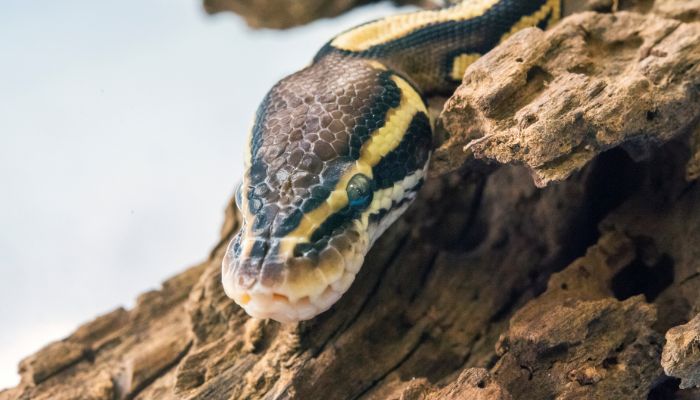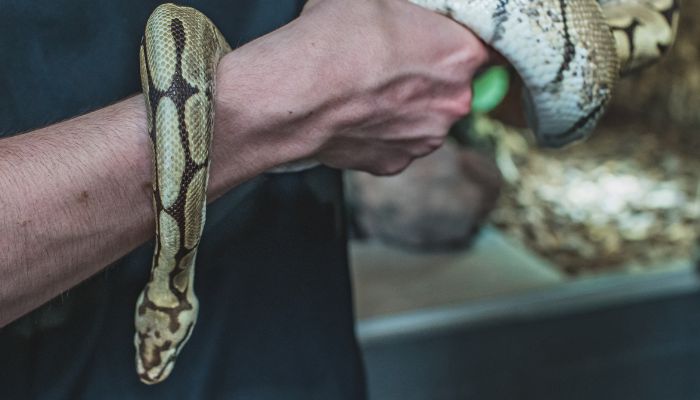
At first glance, these terrestrial creatures might not seem like natural swimmers, but there’s more to the story than meets the eye.
In this article, we delve deep into the fascinating relationship between ball pythons and water.
We’ll explore their natural habitat, their physical ability to navigate through water, and the potential risks and benefits of introducing them to a watery environment.
By the end of this read, you’ll have a comprehensive understanding of the swimming capabilities of ball pythons and the factors that influence their interaction with water.
Dive in and discover the aquatic side of these captivating reptiles!
Table of Contents
- 1 Can Ball Pythons Swim? (Answer)
- 2 The Physical Ability of Ball Pythons to Swim
- 3 Natural Habitat of Ball Pythons
- 4 Ball Pythons and Water
- 5 Risks and Precautions of Swimming for Ball Pythons
- 6 Benefits of Allowing Ball Pythons to Interact with Water
- 7 Tips for Safely Introducing Your Ball Python to Water
- 8 Wrapping It Up
- 9 Frequently Asked Questions
Can Ball Pythons Swim? (Answer)
Ball pythons, like many snakes, have the ability to swim. However, it’s not a common or preferred activity for them. In their natural habitat, they might occasionally come across water bodies and can navigate through them if necessary. Their bodies are designed to move in a serpentine manner, which allows them to swim when required. That said, it’s essential to note that while they can swim, they don’t possess the same affinity for water as some other snake species.
If a ball python (regardless of size) is introduced to water, it should always be monitored to ensure its safety, and the depth should be shallow enough for them to easily lift their head above the surface.

The Physical Ability of Ball Pythons to Swim
Have you ever watched a snake slither on land and wondered how that movement would translate to water? Well, ball pythons, with their graceful and rhythmic movements, can indeed swim, but it’s a sight you might not witness often.
How Ball Pythons Move in the Water
When a ball python finds itself in water, it employs a serpentine motion, similar to its movement on land. This involves pushing against the water in a wavy pattern, propelling itself forward.
The movement is fluid and rhythmic, allowing the snake to navigate through water efficiently. However, it’s essential to note that while they can swim, it’s not their preferred mode of transportation.
They aren’t as adept at swimming as some other reptiles, but they manage when the situation calls for it.
The Buoyancy of Ball Pythons and Their Ability to Float
Ball pythons have a unique body structure that allows them to float. Their bodies are dense, but not so much that they sink like a stone. When in water, a ball python will often float with its head above the surface, taking in the surroundings.
This buoyancy is a survival trait, ensuring they don’t drown. But remember, just because they can float doesn’t mean they’re having a pool party. It’s more of a survival mechanism than a leisure activity.

Natural Habitat of Ball Pythons
To truly understand the relationship between ball pythons and water, we need to dive into their natural habitat.
Description of Where Ball Pythons are Found in the Wild
Ball pythons hail from the grasslands of West and Central Africa. These regions are characterized by a mix of open forests, savannahs, and grassy fields.
While they aren’t typically found lounging near water bodies, they do encounter them occasionally.
The Significance of Water in Their Natural Habitat
Water sources in the ball python’s habitat are crucial for various reasons. Firstly, they provide hydration, essential for the snake’s survival. Secondly, these water bodies might attract prey, making them prime hunting spots.
However, it’s rare to find a ball python taking a casual swim. They approach water with caution, using it as a resource rather than a recreational spot.
Even though ball pythons can swim and have the physical attributes to do so, it’s not a regular activity for them. Their relationship with water is more about survival and less about enjoyment.
So, the next time you see a ball python near water, know that it’s probably on a mission, not a vacation!
Ball Pythons and Water
Water plays a pivotal role in the life of a ball python, much like it does for most living creatures. But how exactly does this terrestrial snake interact with this essential element?

The Importance of Water for Ball Pythons
Water isn’t just a thirst quencher for ball pythons; it’s a lifeline. These snakes need water for hydration, of course, but it also aids in their digestion and overall well-being.
Moreover, during shedding periods, a humid environment facilitated by water helps them shed their skin more efficiently.
This is why many snake enthusiasts ensure there’s a water dish in the enclosure, not just for drinking but also to maintain the right humidity levels.
How They Interact with Water in Their Enclosures
In captivity, ball pythons often have a curious relationship with water. You might find them soaking in their water dishes, especially during shedding periods. This soaking helps loosen the old skin.
However, it’s also not uncommon for a ball python to occasionally defecate in its water dish, which underscores the importance of regularly checking and cleaning the water source in their enclosures.
Risks and Precautions of Swimming for Ball Pythons
While ball pythons can swim, it’s not a leisure activity for them. Introducing them to a large body of water comes with its set of risks.

The Potential Dangers of Forcing a Ball Python to Swim
Forcing a ball python into a swimming scenario can be stressful for the snake. They are not natural swimmers like some other reptiles.
Prolonged exposure to water can lead to respiratory infections or even the risk of drowning if they become exhausted.
Signs of Stress in a Ball Python When in Water
If a ball python is uncomfortable or stressed in water, it might exhibit signs like frantic swimming, constant attempts to escape, or even staying motionless for extended periods.
Observing their behavior is crucial to ensure they aren’t in distress.
Precautions to Take When Introducing a Ball Python to Water
If you decide to introduce your ball python to water, always ensure the water is shallow enough for them to lift their head above the surface easily. The water should be clean and free from chemicals.
Always supervise the snake during its water sessions and limit the duration to prevent exhaustion. And remember, just because they can swim doesn’t mean they should be made to do so frequently.
Benefits of Allowing Ball Pythons to Interact with Water
Water isn’t just a basic necessity for ball pythons; it offers a range of benefits that can enhance their overall well-being.

Helping with Shedding Issues
One of the most significant advantages of allowing ball pythons to interact with water is to assist with shedding. As they grow, these snakes shed their skin, and sometimes, they might face difficulties in shedding completely.
A soak in water can help soften the old skin, making the shedding process smoother and more comfortable for the snake.
Providing Enrichment for the Snake
Just like any other pet, ball pythons also need stimulation and enrichment. Introducing them to water occasionally can provide a change of scenery and a new experience.
This interaction can be both mentally and physically stimulating for them, breaking the monotony of their enclosure.
The Importance of Water Temperature and Cleanliness
When allowing your ball python to interact with water, it’s crucial to ensure the water is at a suitable temperature. Too cold, and it can shock their system; too hot, and it can cause burns. Cleanliness is equally vital.
Fresh, clean water prevents potential infections and ensures a healthy environment for the snake.

Tips for Safely Introducing Your Ball Python to Water
Thinking of letting your ball python have a splash? Here are some pointers to ensure a safe experience.
Guidelines for Those Who Want to Let Their Ball Pythons Swim
First and foremost, always introduce your ball python to water gradually. Start with shallow water and let them get accustomed to it. Never force the snake into the water; instead, allow it to enter at its own pace.
The Importance of Monitoring Water Temperature and Depth
As mentioned earlier, the water’s temperature should be just right – not too cold or too hot. A thermometer can help in ensuring the right temperature. The depth should be such that the snake can easily lift its head above the water.
This ensures they don’t accidentally inhale water.
Advice on Observing the Snake’s Behavior to Ensure It’s Not Stressed
Always keep a close eye on your ball python when it’s in water. Look out for signs of stress, such as frantic movements or attempts to escape. If the snake appears uncomfortable, it’s best to remove it from the water immediately.

Wrapping It Up
In your journey through this article, you’ve uncovered the intriguing relationship between ball pythons and water.
While these creatures might not be the first you’d associate with swimming, you’ve learned that they indeed possess the capability, albeit with certain nuances.
Their natural habitat, physical attributes, and the benefits of water interaction have all been laid out for your understanding.
However, as with all things, caution and knowledge are paramount. It’s essential to recognize the potential risks and ensure the well-being of these reptiles at all times.
Your newfound knowledge equips you to approach the subject with both curiosity and respect. Remember, every interaction with nature, including with creatures like ball pythons, offers an opportunity for learning and growth.
Continue to seek knowledge, ask questions, and most importantly, cherish the wonders of the natural world. Your dedication to understanding and caring for these fascinating creatures is commendable.
Keep up the good work, and may your journey with ball pythons be filled with discovery and joy!
Frequently Asked Questions
Ball pythons and their relationship with water often spark curiosity among snake enthusiasts and owners. Here are some commonly asked questions to shed light on the subject.
Can I put my ball python in water?
Yes, you can introduce your ball python to water, but it should be done with care. While they can swim, it’s not a natural or frequent activity for them in the wild. Always ensure the water is clean and at an appropriate temperature.
How long can ball pythons be in water?
While ball pythons can be in water, prolonged exposure isn’t recommended. A short soak, ranging from 10 to 30 minutes, is usually sufficient, especially if it’s for aiding in shedding. Always supervise your snake during its time in the water.
How often do ball pythons need baths?
Ball pythons don’t necessarily need “baths” in the traditional sense. However, occasional soaks can help with shedding or if they get into something messy. It’s essential to ensure the water is clean and free of chemicals.
Can ball pythons swim underwater?
Ball pythons can swim underwater, but they prefer to keep their heads above the surface most of the time. If they do go underwater, it’s typically for a short duration, and they’ll quickly resurface.
Do ball pythons like warm or cold water?
Ball pythons prefer water that’s close to their body temperature. Cold water can shock their system, while hot water can be harmful. It’s best to aim for lukewarm water when introducing your ball python to a water source.




0 Comments